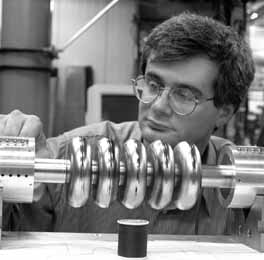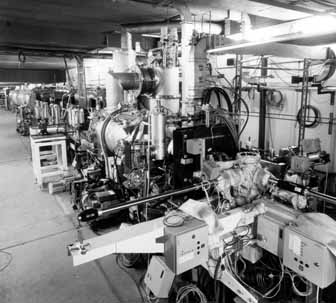 |
|
Fermilab Contributes to TESLA by Chad Boutin
"Fermilab has contributed several pieces of equipment vital to research at TTF," said Helen Edwards of Fermilab's Beams Division. "Both the TESLA electron beam and its electrical power are provided by technology built at Fermilab."
In 1994, Edwards first proposed the idea of the photoinjector. The source of electrons in TESLA's accelerator, the photoinjector is a radiofrequency (RF) gun with a cathode similar to those found in scintillation counters. Fermilab later constructed both the photoinjector and the RF cabinets which accelerate the beam. Helen Edwards and her husband Don, also of Beams Division, have been involved with the TTF collaboration ever since.
"We have also contributed the modulators and couplers that feed power to the RF cabinets," Don Edwards said. "You cannot just plug the RF cabinets straight into a wall socket. It is necessary to modify what the electric company sends you."
The three modulators possess some characteristics of both transformers and capacitors, first altering the AC current from the wall into DC and then sending it to the RF cabinets in controlled 2-millisecond bursts. Even then, the power must pass from the warm environment we live in to the supercooled RF cabinets, which are kept at about 2 Kelvin, which is just above absolute zero. The RF couplers, built by Fermilab's Technical Division, incorporate a cryogenic design to transmit the power into the superconducting cavities without heat loss.
Testing the 9-chambered superconducting cavities that are the heart of the RF cabinet can prove difficult, which all too often means expensive. When designers at TESLA were considering several cavity prototypes, Fermilab's Technical Division provided the vertical dewars that helped ease the selection process.
"If you want to test the superconducting guts of the RF cabinet, it's easier to just stick it in liquid helium," explained Dave Finley, deputy head of accelerator technologies. "The vertical dewars are essentially big helium baths. You can try out each prototype and see which one works best."
Helen Edwards emphasized that Fermilab has also received equipment for research from TESLA and many other institutions.
"The superconducting cavity itself was developed and built in Germany," she said. "We also use a German klystron to amplify our RF power which DESY procured for us, and some of our magnets are from Italy, Cornell, and Jefferson National Lab. This is a mixture of different people helping each other out."
The photoinjector produces a high-quality beam of electrons, which could then be directed through a set of alternating dipole magnets. The magnets would make the electrons wiggle rapidly, emitting a high-energy coherent X-ray beam which could be used to probe the molecular world with unprecedented resolution.
"This new light source would enable advances in what I call the three M's: material science, medicine, and military technology," Finley said. "We hope an X-ray laser will come from this research that will allow us to take rapid pictures on the molecular scale. Among other things, this would actually allow us to take movies of chemical reactions taking place. It's never been done before. Companies would line up to use it. |
| last modified 3/16/2001 by C. Hebert email Fermilab |
FRLsDFx9eyfrPXgV
 Fermilab's longstanding collaboration with DESY-Hamburg has been critical in developing the TESLA Test Facility, with the potential for developing not only the next generation of linear accelerator, but a powerful new laser for industry.
Fermilab's longstanding collaboration with DESY-Hamburg has been critical in developing the TESLA Test Facility, with the potential for developing not only the next generation of linear accelerator, but a powerful new laser for industry.
 Research at TESLA and the smaller accelerator at A Zero could lead to a more efficient and cheaper linear collider in the future (see JJ's article). But most everyone involved hopes it will help out with something else as well: the development of a high-precision light source.
Research at TESLA and the smaller accelerator at A Zero could lead to a more efficient and cheaper linear collider in the future (see JJ's article). But most everyone involved hopes it will help out with something else as well: the development of a high-precision light source.